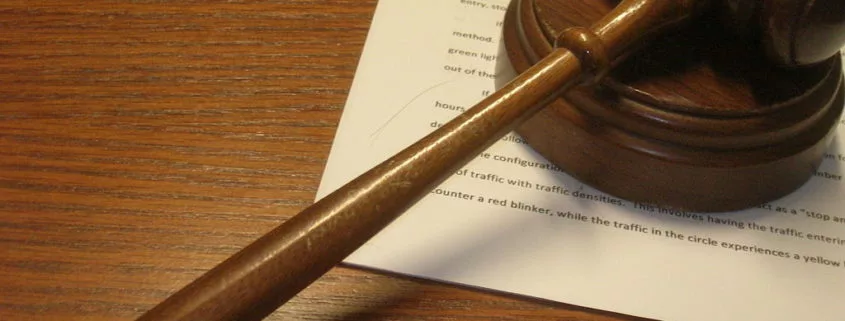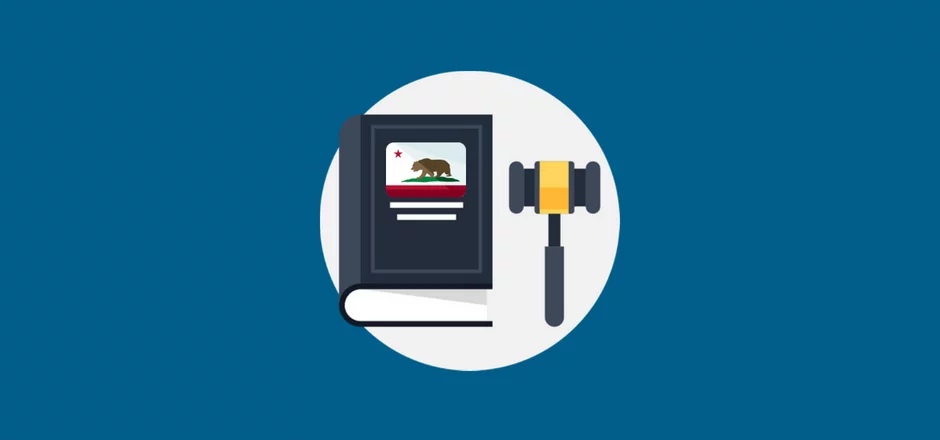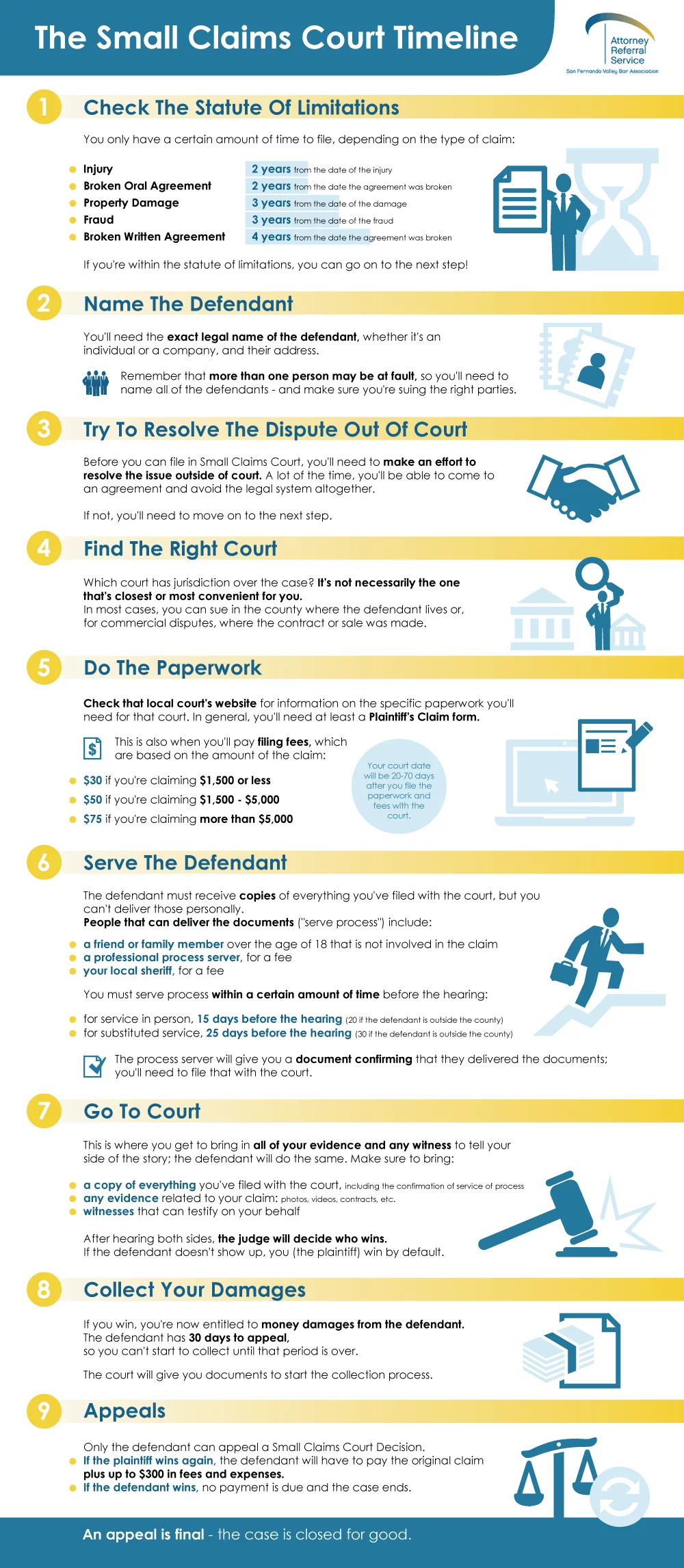How to File A Claim In Small Claims Court In California
You can take just about any dispute involving $10,000 or less to small claims court in California.
158,347 small claims were filed in California last year (2017 Court Statistics Report)
If you find yourself chasing a security deposit or payment for $10,000 or less, you can file a small claims suit to resolve the issue.
In small claims court, there are no attorneys, juries, or special courtroom procedures. In most cases, the only people involved are the plaintiff, the defendant, and the judge.
Today, we’re taking a closer look at how to file a claim in small claims court in California.
Let’s get started …
How to File A Claim In Small Claims Court In California
To file a claim in small claims court, visit your county clerk’s office and let them know you would like to file a small claim. The clerk’s office will provide you with the paperwork needed to start the process. This paperwork will ask for some basic information, including your name (the plaintiff), the name of the person or business you’re suing (the defendant), and the amount of money you’re seeking.
There are a number of steps you need to follow in order to successfully file a claim in small claims court, so please take a look at the following carefully.
If you’re not comfortable with this process, you may want to find an attorney to help.
Step 1. Check The Statute Of Limitations
First, you’ll need to make sure you’re within the “statute of limitations” – the amount of time you have to file a claim. If you’re suing because of an injury or a broken oral agreement, you have 2 years from the date of the injury or the date the agreement was broken. If you’re suing for property damage or fraud, you have 3 years to file. If you’re suing for a written agreement, you have 4 years.
Step 2. Name The Defendant
If you’re within that time period, you can move forward with your legal claim. You’ll need to find the right way to name the defendant, which can be harder than it sounds. You have to have the exact name of the person or company you’re suing and you also have to make sure they’re the right defendant. If you’re suing because someone sold you a bad product, for example, should you sue the person that sold it or the person that made it in the first place? Remember that you can also sue more than one party at the same time, as long as it’s for the same claim.
Step 3. Try To Resolve The Dispute Out Of Court
Next, you’ll need to track down that defendant and simply ask for the money – you have to try this out-of-court option before you can go to the California Small Claims Court. In many cases, that’s all it takes and you won’t have to go to court at all.
Step 4. Find The Right Court
If asking for money doesn’t work, you’ll need to move forward with filing – that means finding the right Small Claims Court. You can’t simply file at the one that’s most convenient for you; there are rules about where you have to file. If you’re suing over a car crash, for example, you can sue either in the county where the crash happened or in the county where the defendant lives. In most cases, you can file where the defendant lives or, for commercial disputes, where the contract or sale was made. California maintains a list of the the appropriate place to file based on your claim.
Step 5. Do The Paperwork
You’ll have to file several forms in order to get your claim into court. First, there’s the Plaintiff’s Claim form, which explains who you are, who the defendant is, how much money you’re claiming, and why. If that form doesn’t give you enough room to describe the situation, you can use this one for extra space. And if there are multiple plaintiffs or defendants, you’ll need to use this form to list the other parties. If the plaintiff is a business, it may need to file this form if it’s doing business (“dba”) under another name. Your local court may also require certain other forms, so you’ll need to check their website or contact them to find out what other paperwork is necessary.
Now that you have your paperwork ready, you can take it to the appropriate court and file it with the clerk. You’ll need to pay a filing fee based on the amount of your claim:
- $30 if you’re claiming $1,500 or less
- $50 if you’re claiming $1,500 – $5,000
- $75 if you’re claiming more than $5,000
If you’ve filed more than 12 cases in the past year with the Small Claims Court, the filing fee will be $100 for the 13th and subsequent claims. If you can’t pay the fee, you can ask the court for a fee waiver.
You’ll be assigned a court date once you file your paperwork; it will usually be within 20-70 days after you file.
Step 6. Serve The Defendant
You have to let the defendant know you’re suing them and on what grounds – you have to give them a copy of every document you’ve filed with the court. That’s called “service of process.” If you don’t properly serve the defendant, your case may be dismissed. The process server can’t be involved in the case – you can’t do it yourself. It has to be someone over the age of 18 with no relation to your claim. So, it could be a friend or family member. Your local sheriff can also serve process, as can an official process server, but you’ll have to pay a fee. There are three types of service:
In Person Service
Service can happen in person – the process server simply needs to hand the papers to the defendant and let them know that they’re court papers. Then the server must fill out this form and you’ll need to sign it and file it with the court.
Personal service has to happen at least 15 days before the court date, or 20 days if the defendant is outside of the county.
Substituted Service
If they won’t take them, the server can simply leave it near them. If the server can’t find the person, they can use “substituted service” and deliver the documents to:
- a person over the age of 18 that lives with the defendant
- a person over the age of 18 who is in charge where the defendant is employed, OR
- a person over the age of 18 who is in charge where the defendant receives mail
The process server will need to fill out this form and you’ll need to sign it and file it with the court. In addition, the server must mail a copy (by first class mail) of all of the court filings to the defendant at the same address where he or she served the papers originally and fill out this form. You’ll need to file that form with the court as well.
You’ll have to give service of process at least 25 days before the court date if the defendant is in the county in which you’re filing the claim or 30 days before the court date if the defendant is outside the county.
Service By The Court Clerk
For a small fee, the court clerk can mail your documents to the defendant. However, it won’t always do the trick. The person receiving the document (either the defendant or another person that can sign for his or her mail) has to sign for the documents using the defendant’s full name. If someone else signs it or if the signature is not legible, the service won’t count and you’ll have to serve the defendant again by another method.
Step 7. Go To Court
Finally, it’s time to actually go to court. You and the defendant will both have an opportunity to explain your side of the case. You should prepare ahead of time to figure out what you’re going to argue and what evidence you’re going to use. Bring any relevant documents such as contracts, photos, police reports, and anything else that supports your claim. You can also bring in witnesses. Don’t forget to bring a copy of the paperwork you’ve filed with the court and of the service of process.
If the defendant doesn’t show up in court, you win by default. However, if the defendant can show a valid reason (a medical emergency, for example) for missing the court date, he or she may ask the court to vacate the default judgment and set another court date.
Step 8. After The Court Date
If you won, you’re now entitled to money from the defendant. However, you can’t start collecting until 30 days after the hearing (that’s how long the parties have to appeal). The court will provide you with the documents you need to start the collection process.
Start by giving the defendant your address so they have a place to send the money. You may talk to the defendant and agree to different payment terms if you want; you may agree to take a smaller amount of cash up front or to allow the defendant to pay in installments. You should put any agreement like that in writing and make sure you both have copies.
If they don’t do it by the time stipulated in the court order, send them a letter asking for the money and include a copy of that court order. Use certified mail so you have a record that they received it and keep a copy of the letter yourself.
If that still doesn’t get the defendant to pay, you’ll need to bring in a lawyer to talk about more serious options for pursuing payment.
Step 9. The Appeals Process
Only the defendant can file an appeal over a decision in a California Small Claims Court. They must file within 30 days of the hearing. This is considered a new trial, so you’ll be in front of a different judge and you’ll have to make your case again from scratch. Appeals are heard in civil court, so you and the other party can have lawyers with you.
This appeal is final. If the plaintiff wins, the defendant must pay the money (or potentially more, if the judge decides that is fair) and may have to pay up to $300 of the plaintiff’s court fees, attorney fees, and other costs associated with the claim. The plaintiff can also start the collection right away.
If the judge decides that the defendant appealed “in bad faith” – usually as a way to harass the plaintiff – you may have to pay up to $2000 in attorney fees and other costs. Filing in bad faith means you either filed the appeal without any real support for your position, to harass the plaintiff, or to get the plaintiff to give up on the case.
If the defendant wins, he or she doesn’t have to pay anything and the case is over.
Is Small Claims Court Right For You?
There’s no definite answer to the question of whether this is the best choice for your claim.
Small Claims Court is great for relatively simple cases and for plaintiffs that are comfortable managing the logistics and proof on their own. If you’re in doubt about which is right for you, consider having a free consultation with an attorney to get a better sense of how your case might go and whether you can handle it on your own in a California Small Claims Court.
Conclusion
If you’re unable to resolve a legal matter involving $10,000 or less out of court, filing a claim in small claims court may be your best option.
The process is relatively simple, but you may find it helpful to bring your lawyer in on the case to ensure you follow the steps correctly and successfully file your claim.
If you need help finding an attorney to help, let us know.
Are you in search for a certified attorney to represent you?
Let us help you find one today!








If it’s way past the statue of limitations can somebody still take you to small claims court for verbally acknowledging the debt?
Hi Jason,
We need a little more information in order to provide an accurate answer – please tell us more about the situation using this simple form: https://sfvbareferral.com/find-a-lawyer/
If there was a verbal agreement and an email. What is the time limit on this?
Hi Elvia,
Section 339 of California’s Code of Civil Procedure establishes a two-year statute of limitations for oral contracts. California courts will enforce oral contracts unless a statute requires a written agreement. For example, home-improvement contracts between a homeowner and contractor must be in writing.
Let us know if we can help you find a lawyer for assistance – We’re always happy to help!
I have been charged for overdrawn fees, and return check fee’s in My Bank
for a Service (secret shopper) that I have completed for a total of $4,480 not including Bank Charges, that keep adding up. My bank says that checks were Fraudulent, and I am now in the negative and getting worst !!!! I have a name but how do I know to create a Claim if the person isn’t real?? HELP?
Hi James,
You might be able to find some helpful information here → lacounty.gov – they have an area with frequently asked questions that might cover the topic.
I loaned my ex husband 4000 that he won’t pay back. Because of this I’m broke and my phone is shut off. Where do I start to take him to court
Hi Lisa,
visit your county clerk’s office and let them know you would like to file a small claim. For more information visit lacounty.gov.